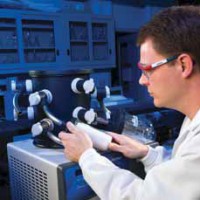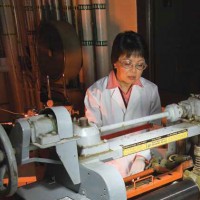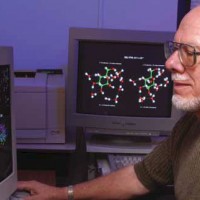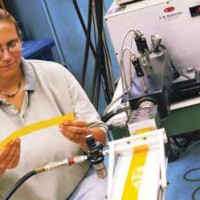‘Replace’ a big word at the ag lab
At the USDA National Center for Agricultural Utilization (NCAUR), known locally as the Ag Lab, there is an important word added to the mantra of Reduce, Reuse, and Recycle: Replace.
That word represents a large portion of the research that is conducted at the lab, research that involves finding ways to replace petroleum products with those made from renewable resources.
The Plant Polymer Unit (PPL) is one of seven research divisions at NCAUR. Polymers are nothing new; they’ve been around since the beginning of time and are a part of all living things – people, plants and animals. Natural polymers began to be chemically modified into many useful materials in the 1800s. But when the advent of World War II cut off access to polymers from natural sources, synthetic polymers became a critical need.
The rest, including the use of synthetic polymers in all manner of plastic materials and their growth into a mega-industry, is history.
Researchers in the PPL unit at NCAUR find ways to replace the use of synthetic polymers by developing materials from renewable resources. Their technologies create new market opportunities for co-products, or leftovers, of biofuels production and leave reduced environmental footprints compared with products from non-renewable sources.
Following are some examples of those technologies, and a bit of insight into the people who are making our lives better through the use of plant polymers.
Adhesives: Dr. Mila Hojilla-Evangelista, research chemist at NCAUR, has focused her scientific career on the protein components in corn, soybeans, and alternative oilseed crops. She developed soybean flour-based plywood adhesive used by U.S. manufacturers as an alternative to a widely-used formulation containing animal blood. She has since expanded that work to plywood glue that uses corn germ protein, which also shows strong potential to enter the wood products market.
“Since childhood, I’ve been interested in the sciences. My mother was a science teacher and I remember her specimen jars of preserved creatures. Some were gross – but it got me interested in the process of experimentation and discovery.
“What I most love about my work is the constant learning process and developing new things. Getting there can be frustrating, but when I arrive, it is a great feeling.” ~ Mila
Biobased products: Before new products can be made from biobased materials, there needs to be an understanding of how to improve the performance and processing of those materials. That starts by understanding the molecular structures and the relationships between the properties the materials contain, such as starch and cellulose.
Dr. Frank Momany, a research chemist whose 50 year science career has included professorship and building/leading his own company, focuses on computer modeling of starch and cellulose structures.
Dr. Victoria Finkenstadt, research chemist, studies the way biobased materials function, such as mechanical properties, durability and degradation.
Together they work to determine how changes in structure create changes in function and vice versa. Their research generates the understanding of materials needed to develop new biobased products, such as food and electronics packaging and absorbents that control erosion and the release of agricultural chemicals.
“In my early career, chemistry and basketball were both big parts of my life and twice I chose to follow chemistry rather than basketball as a career. When opportunities for playing and coaching basketball at the professional level were available, choosing chemistry was based on the recognition that basketball could be a part-time aspect of my life but it would be a lot harder to be a part-time chemist. Now, I use science and creativity to garden in my spare-time and my urban garden has won a regional award for environmental innovation. Who would have known?” ~ Vicki
“I don’t think I was all that bright, but I was persistent. I liked to solve problems and figure things out and that’s what science is. My first structure and modeling project required that I travel to Iowa to use a computer the size of this lab wing. Later, our university got one that was as small as my office – it was heaven!
“We used to literally put ourselves through contortions to create physical structure models out of metal rods and cut aluminum – after I left teaching I started a company that developed the first software to do it all on a computer. We could never have envisioned then what we are able to do now with the (very high powered) computer that sits on my desk and I’ve liked it all. Things change enough that there is always something new. But at 77 years of age, I’m beginning to think the new thing I might like to try next is sleeping in until 8 a.m.”~ Frank
Reinforcing particles: Carbon black is a petroleum-based product and the dominant particles used in rubber products to improve properties such as strength.
Replacing it with renewable agricultural byproducts and feedstocks would contribute to using less petroleum. Dr. Steve Peterson, NCAUR research chemist, is currently focused on replacing carbon black with renewable agricultural byproducts and feedstocks that would contribute to using less petroleum.
Biochar, a charcoal-like material created by “burning” organic material in the absence of oxygen, is an example of a potential replacement for these fillers. Biochar can also be used as a water management tool and in controlled-release fertilizers.
“My high school chemistry teacher really encouraged me to look into a science career and directed me to ISU and their cooperative-learning program. That resulted in my working at The Eastman Kodak Company for a summer and really getting to see how different science degrees led to different careers.”
“I expected a lifelong learning process about science; what I did not expect is what I have learned about trust and teamwork. The technicians here are very experienced and knowledgeable – from repairing complex equipment to helping design lab experiments to introducing me to other researchers in the building for potential collaboration. Instead of having to do everything myself, I’ve learned with that high caliber of people and equipment I can accomplish exponentially more research if I get out of their way.” ~ Steve




